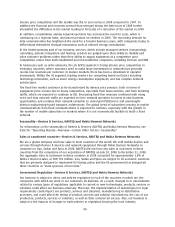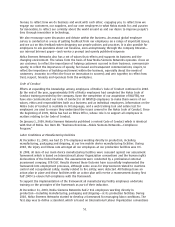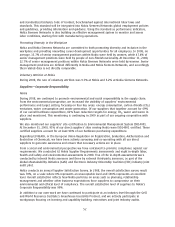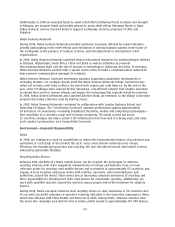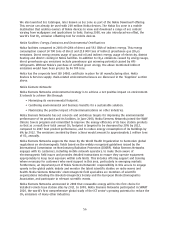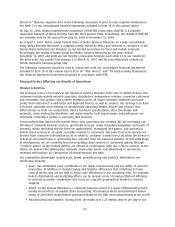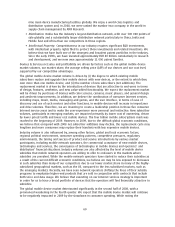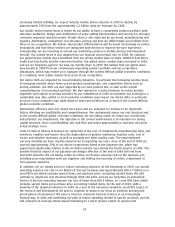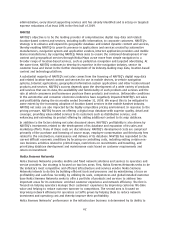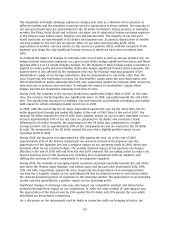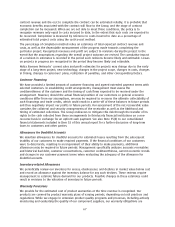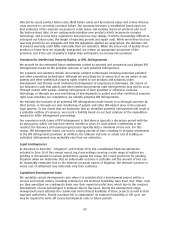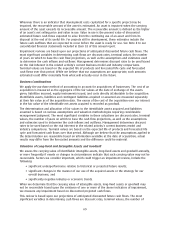Nokia 2008 Annual Report Download - page 60
Download and view the complete annual report
Please find page 60 of the 2008 Nokia annual report below. You can navigate through the pages in the report by either clicking on the pages listed below, or by using the keyword search tool below to find specific information within the annual report.Structure.” Business segment data in the following discussion is prior to intersegment eliminations.
See Note 2 to our consolidated financial statements included in Item 18 of this annual report.
On July 10, 2008, Nokia completed the acquisition of NAVTEQ Corporation. NAVTEQ is a separate
reportable segment of Nokia starting from the third quarter 2008. Accordingly, the results of NAVTEQ
are available only for the period from July 10, 2008 to December 31, 2008.
As of April 1, 2007, Nokia results include those of Nokia Siemens Networks on a fully consolidated
basis. Nokia Siemens Networks, a company jointly owned by Nokia and Siemens, is comprised of the
former Nokia Networks and Siemens’ carrierrelated operations for fixed and mobile networks.
Accordingly, the results of Nokia Group and Nokia Siemens Networks for the years ended
December 31, 2007 and 2008 are not directly comparable between each other or to our results for
the prior years. Our results from January 1 to March 31, 2007 and for preceding years include our
former Networks business group only.
The following discussion should be read in conjunction with our consolidated financial statements
included in Item 18 of this annual report Item 3D. “Risk Factors” and “ForwardLooking Statements.”
Our financial statements have been prepared in accordance with IFRS.
Principal Factors Affecting our Results of Operations
Devices & Services
The principal source of net sales in our Devices & Services business is the sale of mobile devices. Our
customers include mobile network operators, distributors, independent retailers, corporate customers
and consumers. Our product and services portfolio covers all major consumer segments and price
points from entrylevel to midrange and highend devices as well as services. Our strategy is to have
a focused, optimallysized offering of commercially appealing mobile devices and services that
differentiates us from our competition. Device hardware specifications, attractive design and
materials, valueadding functionalities and regionspecific local requirements and preferences are
important competitive factors in achieving that objective.
Functionalities that improve the mobile device user experience are evolving. We are increasing our
offering of consumer Internet services, specifically in music, maps (including navigation and points of
interest), media (including the Ovi Store for applications), messaging and games, and working to
deliver those services in an easily accessible manner to consumers. Net sales from such services are
derived from consumer subscriptions paid in advance, consumer transactions paid when the service is
delivered, and advertising or sponsoring fees collected from our business partners. At this early stage
of development, we are currently focused on getting those services to consumers quickly through
“combos” where certain mobile devices are offered in combination with one or more services. In the
future, we believe that subscription renewals, transaction levels, and advertising or sponsoring
revenues will increase as a proportion of overall services net sales.
Our competitive advantages include scale, brand, manufacturing and logistics, distribution and
intellectual property.
•
Scale:
Our substantial scale contributes to our lower cost structure and our ability to invest in
innovation. In addition to manufacturing and logistics efficiencies that contribute to lower
costs of goods sold, we are able to enjoy scale efficiencies in our operating costs. For example,
Nokia’s distribution and marketing efforts can be spread across a broad portfolio of offerings,
in contrast to smaller competitors that focus on a specific geographical market or product
segment.
•
Brand:
As the devices business is a consumer business, brand is a major differentiating factor,
having broad effects on market share and pricing. The Business Week and Interbrand annual
rating of 2008 Best Global Brands positioned Nokia as the fifth mostvalued brand in the world.
•
Manufacturing and logistics:
During 2008, we made over 1.25 million devices per day in our
59


